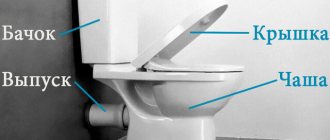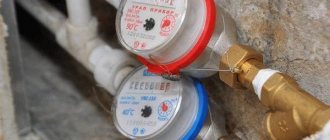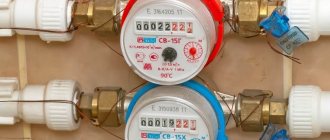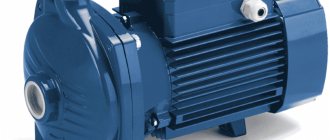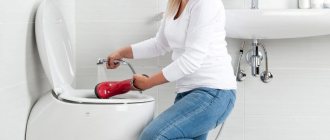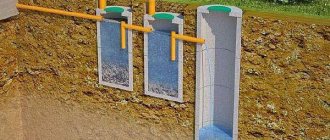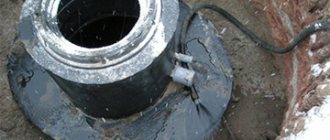Water meters have become as familiar to us as electric meters. But if the task of accounting for electricity does not present any particular difficulty, then with water everything is completely different.
This explains such a wide variety of instruments for measuring it: trying to come up with the most accurate method of measurement, engineers are coming up with new designs.
In this article we will study the design of a water meter and evaluate the advantages and disadvantages of each type of these devices.
Scope of application
The vast majority of water meters are purchased today by subscribers of centralized water supply networks.
The devices used to measure water - cold and hot - differ from each other.
The first ones are designed for an ambient temperature of no higher than +40 degrees, are cheaper and are marked in blue.
The latter operate at temperatures up to +150 degrees and are more expensive due to the use of special heat-resistant materials. Marking color is red. Today, models are produced in which both types of meters are combined in one housing. This device costs less than two separate ones.
Today, a system for remote control of water consumption is being actively implemented. Its operation requires meters equipped with a transmitting module, a kind of analogue of a computer network card. After connecting such a device to the network, data from it is sent to the settlement center automatically. Pulse and digital modules transmit data over a cable network, while radio frequency modules operate wirelessly.
Hot water meters with a pulse module are used not only as independent equipment, but also as a component of meters for heat supply systems.
Which ones are better for an apartment and which ones for a private house?
Flow meters for measuring water consumption in a private and multi-storey building are the same, but the requirements for their installation differ.
If there is a central water supply in the village, the installation of the unit outside the city is carried out in a well, near the highway. The source must be sealed, and only inspectors of the supplying organization have access to it. If the water in the house comes from its own well, and the wastewater is discharged into the general sewer system, installation of a meter is also required to determine the sewage coming from residents and pay the cost of services.
Similar titles
To avoid confusion, let us clarify the terminology issues. “Water meter” is just one of the names; other names are also used:
- flow meter;
- water meter;
- water meter
About meters equipped with a transmitting module, it is customary to say: a meter with such and such an output.
For example, a meter with a radio output. These meters can also be called flow sensors or flow converters.
An integral component of any water meter - a section of pipe through which the medium flows - is usually called the flow meter section.
Functional features of flow meters
In everyday life and self-financing of public utilities, storage water meters are used. That is, the device only records the agent’s passage and summarizes the indicators on the counter scale. With the installation of a pulse sensor, readings can be transmitted remotely.
In technological lines, devices not only record the passage of the agent through the pipe, but are connected to a valve that regulates the flow. Their choice depends on the nominal diameter, pressure and viscosity of the liquid.
Flowmeters-dispensers with a shut-off valve are also built on the general principle of changing the indicators of the electromagnetic, light flux, and rotation speed of the internal vane sensor. The water meter passes the exact amount of water and the valve is activated, cutting off the flow.
Design and design of a water meter
You can study the history of physics using water meters. As soon as a new discovery is made in this science, engineers immediately try to adapt it to calculate water consumption. Let us list the types of water meters that exist today.
Many people buy water meters without thinking about the characteristics of the device. However, flow meters are different. Water meters: we’ll tell you in this article how to choose the optimal model.
See the comparative characteristics of acrylic and steel bathtubs here.
And in this topic https://aquacomm.ru/cancliz/mnogokvartirnyie-doma/santehnika/oplombirovat-schetchiki-na-vodu.html we will explain how and where you need to seal water meters and whether you need to pay for this service.
Tachometer
The second name is mechanical. The design of these devices is extremely simple and resembles a water mill.
Here, too, there is a semblance of a rotating wheel - an impeller, only it drives not the millstones, but the gear mechanism, and that, in turn, drives the rollers of a mechanical display with printed numbers.
For significant water flows, the impeller does not provide the required accuracy, so a turbine is used instead.
Turbine water meters have a diameter of DN50 and above, and vane water meters have a diameter of less than DN50. The nuance is that the turbine also does not always give sufficiently accurate readings - its error becomes excessive precisely at low flow rates. What should users do if their water consumption varies widely? We came up with a solution: a combined meter, essentially consisting of two – a vane and a turbine. The water flow is redirected to one or the other automatically, depending on the speed.
The accuracy of measurements is also affected by the nature of the flow of the medium: in the presence of turbulence, the error increases. This phenomenon is minimized in the so-called. multi-jet meters equipped with a flow separator. They are slightly larger than conventional ones (single-jet), but are more accurate.
Mechanical flow meters also differ in the design of the counting mechanism, which can be wet or dry. In the first case, the gearbox and display rollers are washed with water, and the impeller is directly attached to the gear or worm shaft. In the second, all the “filling”, except for the impeller, is located in a hermetically sealed box, and a magnetic coupling is used to transmit rotation. “Wet” meters are cheaper, but with a significant amount of mechanical impurities in the water they quickly fail. “Dry” solid contaminants are less afraid and allow you to dismantle the counting mechanism without turning off the water, but are somewhat more expensive.
Mechanical counter
Mechanical meters have a number of disadvantages:
- Acceptable accuracy is observed only over a narrow range of flow rates.
- They have a relatively short service life due to the presence of moving elements.
- High hydraulic resistance.
- The current water consumption is not displayed.
- A strainer must be installed in front of the device.
Nevertheless, it is these devices that have become the most in demand, at least in everyday life. There are several reasons:
- mechanical meters do not require an electrical connection;
- simple maintenance;
- low cost.
All other types of meters, which will be described below, are volatile, that is, they require a source of electricity to operate. In addition, they are more expensive than mechanical ones. But they have important advantages:
- demonstrate high accuracy, both at low and high flow rates;
- due to the absence of moving elements, they are more reliable and durable than mechanical ones;
- characterized by low hydraulic resistance;
- can show current water consumption and store data archive.
Why can’t we limit ourselves to just one type of electronic meters? The fact is that each of them, as we will see later, has its own weaknesses.
Ultrasonic
In the flow-measuring section of such a device, two or four elements are installed that are capable of generating and capturing ultrasound.
The computing module analyzes the received data.
The disadvantage of an ultrasonic counter is the following: if there are a significant number of bubbles in the water, its accuracy drops significantly.
Electromagnetic
Such a device also has a computing unit, and the working part consists of inductive coils and a voltmeter. The pipe through which the medium flows is made of a dielectric material, usually polyethylene or fluoroplastic. The weakness of these meters is the high error during turbulence. In addition, they can quickly become clogged with metal particles held by the magnetic field.
A prerequisite for the operation of an electromagnetic meter is the electrical conductivity of the transported medium, therefore they cannot be used to calculate the consumption of substances such as alcohol or petroleum products.
Resonant
These devices are also called superstatic. This time, a piezoelectric frequency sensor is responsible for counting liters and cubic meters, and the pipe is divided into three channels and equipped with a flow shaper. The device is afraid of solid impurities, so it is advisable to install a mesh filter in front of it.
Vortex
Inside the pipe of this flow meter there is an element with a special geometry and a pressure sensor.
The latter's readings are converted into digital data by the computing module.
Due to the susceptibility of the streamlined element to abrasive wear, they have the same short service life as mechanical ones - from 8 to 12 years (other types can last up to 25 years).
How it works: mechanism-type design
To perform volume measurements in hot and cold water supply systems, different types of mechanisms are used.
Winged
The impeller mechanism looks like a wheel with blades attached to it . The rotation axis is perpendicular to the direction of water movement. The sensitivity of such a mechanism is high, but the wheel greatly blocks the flow and slows down the progress of water. This is its disadvantage.
If the impeller is made of low-quality material, it quickly breaks under the pressure of water. Replacing meters is associated with additional financial costs for the purchase of a new water meter and installation.
Single jet
In pipelines of small diameters, up to 50 mm, when water completely fills the gaps, a single-jet mechanism is installed.
The water meter measures the number of revolutions of the impeller, which rotates under the influence of the water flow. If the meter is equipped with a pulse output, it can read readings remotely.
Multi-jet
The multi-jet mechanism splits the flow into several channels, and the water presses on the impeller in equal parts. Turbulence is reduced and the error in such calculations of water volume is no higher than 2%.
Installing a water meter and taking readings is simple . To check the meter, you need to remove its cover.
Turbine
Turbine mechanisms measure large flows of water. The appearance of turbines is similar to a conventional impeller, but the number of blades is fewer.
The axis of rotation is parallel to the water flow . To improve measurements, a fairing is installed in front of the turbine to reduce turbulence.
All the most important and useful information about water meters is presented in this section.
Principle of operation
If everything is clear with mechanical counters, then the operating principle of other types should be explained:
- Ultrasonic: sensors installed at the beginning and end of the flow-measuring section operate alternately in generator and receiver modes, “driving” ultrasound either in the direction of the associated water flow or in the opposite direction. The water flow is determined by the computing module based on the difference in time required for the oscillations to overcome the area between the sensors in the forward and reverse directions.
- Electromagnetic: the operating principle of devices of this type is based on the phenomenon of electromagnetic induction. In a conductor moving in a constant magnetic field, a force (electromotive) arises, the magnitude of which depends on the speed of movement of the conductor. In this case, the role of a conductor is played by the flow of water, and the magnetic field is generated by inductance coils.
- Resonant: the meter is designed so that part of the flow returns to the beginning of the flow meter section, either through one or another additional channel. The frequency of channel changes (it is recorded by a piezoelectric sensor) depends on the flow rate, and therefore on the flow rate.
- Vortex: due to the special shape of the element located inside the meter, the flow of water around it forms vortices, accompanied by pressure drops.
Based on the frequency of these changes, the computing module determines the flow rate and flow rate.
What it consists of, materials used
Mechanical dry-running, single-jet water units are a reliable product for precise control of water consumption. These structures are most often installed in water supply systems of apartments and private houses.
The operation of the flow meter is based on tachometer measurement of the fluid flow passing through the compartment with the impeller. The product body consists of two chambers, isolated from each other by a dividing membrane:
- in the chamber with the working element, the passing water flow, directed perpendicular to the axis of the wheel, rotates the shaft through the impeller installed on it. A magnetic disk is fixed on the axis (towards the separating membrane), which non-contactly, through an insulating membrane, transmits the rotation of the impeller to the water meter mechanism;
- in the chamber with the reduction-counting mechanism, on the axis of the gearbox, in the direction of the separating membrane, a magnetic half-coupling is mounted. The rotation of the impeller axis is transmitted to the gearbox shaft of the unit through the magnetic coupling of coupling halves from different chambers. The counting mechanism converts the impeller revolutions into cubic meters of flowing liquid. The connection of the working element with the reduction-counting mechanism due to the magnetic field is unstable, the rotation of the meter can be slowed down by the external influence of a permanent magnet;
- the housing with the working mechanism of the water supply meter is made of metal alloys: brass, copper or bronze, resistant to corrosion. The working chamber is made with two oppositely located threaded pipes for connection to the water supply. A filter mesh is installed at the entrance to the chamber, and a check valve is installed at the exit.
The impeller, or impeller, is made of heat-resistant plastic. To support the wheel axle, watch stones are used, which increases the accuracy of the device by reducing friction.
On the axis of the impeller there is a magnetic disk - a half-coupling, rotating together with the blade wheel.
The body of the working chamber is hermetically sealed with a lid made of a magnetic field-transmitting polymer. In the cavity, in the center of the membrane, there is a magnetic disk.
The body of the counting mechanism is made of plastic and is connected to the working body, a belt-collar made of polymer, and sealed with a factory seal.
Inside the chamber there is a gearbox with a magnetic coupling on the shaft, coaxially located with the disk in the working part of the device. Through the gearbox, rotation is transmitted to the flow indicator, and from it to a small meter and a digital scale in the form of rollers, from which the volume of water passed through the device is read.
The control and measuring instruments of water supply systems include a water meter-wet meter. Unlike the described water flow meter, the shaft of the device's counting mechanism is kinematically connected to the axis of the working element, through the bushing of the dividing partition. Liquid enters the metering chamber, acting as a lubricant for the reading device.
- A tachometer turbine meter consists of a working chamber in which a multi-pass shaft with a mounted turbine is located horizontally to the fluid flow, and the turbine is vertical. The flow measurement is associated with the revolutions of the turbine, from which the rotation is transmitted to the reduction-counting mechanism.
- A water meter with a pulse output is identical in design to a mechanical one. The working housing houses the impeller, and the chamber of the reduction-counting mechanism contains a dial indicator for calculation. In the dial, at the starting point, there is a sealed contact, and on the hand there is a magnet. When it passes a revolution and the reed switch enters the magnetic field, the contact closes, and information about the consumed water is transmitted remotely through a pulse.
Specifications
When purchasing a water meter, the following parameters should be taken into account:
- Connecting diameter or nominal diameter (DN or DN).
- Maximum permissible pressure in the system (PN or PN). Specified in atmospheres or bars (both units are identical).
- Maximum flow (Qmax): the maximum permissible supply of medium that the meter can withstand for a short time (no more than an hour per day and 200 hours per year), maintaining the accuracy of readings within the required limits.
- Nominal flow Qn: the maximum flow with which the meter is capable of operating in continuous mode.
- Transition flow Qt: the limit after which the accuracy of the device readings changes.
The minimum flow rate Qmin is also important - the smallest flow at which the meter readings remain fairly accurate.
Installing a water meter is a fairly simple procedure, so it is not necessary to call a specialist when you can save a little. Installing water meters yourself - determining the installation location and putting the device into operation.
You will find everything about arranging a summer water supply at your dacha in this material.
With pulse output
Devices with a pulse output transmit readings directly to the management company’s computer. It is very comfortable. Such devices are used in smart home systems. But not all management systems take readings through a pulse output.
Connection requires installation of additional equipment (cable or modem).
Doppler method
Counters operating using this method measure the difference in wavelength reflected from a moving stream relative to the wavelength of the emitted signal. Measuring the received and transmitted signals to determine the difference between them is done using wedge-shaped or pipe speed sensors installed at the bottom of the channel or pipe.
Water meters operating on the Doppler effect are used in pressure and gravity systems, fully and partially filled pipes, and open channels. They work in streams of varying degrees of pollution (except clean water). Doppler flow meters are used for commercial metering in pipelines and gravity canals, for measuring flows in rivers and canals of irrigation systems, in storm sewers, at pumping stations, water intake pipelines and discharge of wastewater into reservoirs.
Analogs
Among Russian analogues, the following manufacturers can be distinguished:
- "Betar";
- "Pulse";
- "Meter"
- "Economy";
- "Water device."
Among the foreign manufacturers competing are:
- "Valtec"
- "Itelma";
- Zenner.
Does the reason for the change affect the course of action?
The following factors may be possible reasons for replacement:
The service life has come to an end. In this case, when replacing the device, the owner will additionally have to dispose of the old meter;
Guarantee period
The warranty for Norma IS meters is 30 months, starting from the date of installation and activation of the operating mode, but not more than 36 months from the date of first verification.
According to the technical documentation , warranty repair will be denied if:
- the breakdown occurred as a result of improper use (see the operating instructions for the device);
- transportation or storage conditions are violated;
- the quality of the hydroflow does not meet sanitary standards (SanPiN 2.1.4.1074-01).
Why do you need water metering?
Despite the obviousness of the answer, many segments of the population are in no hurry to install metering devices until there is an official order. This inertia is caused by the fact that over many years, when water utility services cost mere pennies, we did not pay attention to consumption standards. With rising prices for utilities, this expense item has increased significantly. Based on this, we can list all the advantages of installing a hot and cold water flow meter:
The listed factors are quite sufficient to explain the need to install water meters.
Documents required for self-replacement
When purchasing a counting device, you need to pay attention to the presence of a certificate that comes with the equipment.
After replacing the water meter yourself, you need to seal it (this is done by inspectors of the Management Company or Vodokanal). To register a water meter, the following documents are required:
- technical passport for a new water meter;
- state verification act.
For commissioning, all of the listed documents are submitted to a government agency (for example, in Moscow this is the EIRTs), where the device is registered.
Reviews
Consumers often trust Norma meters to track water consumption in their homes.
According to the majority of those who have used these water meters, they are inexpensive, high-quality, reliable devices with high accuracy in recording readings and a laconic design that is not conspicuous.
In addition, a large calibration interval and long service life, which allows you to forget about verification or replacement procedures for a long time, attract buyers.
Reference! There are cases of manufacturing defects, but the problem is easily solved by replacing the device or repairing it under warranty.
Customer reviews can be found here and here.
Criterias of choice
Before purchasing a meter, you should consult your local water utility. Experts will give clear recommendations regarding the type of device (for example, mechanical or vortex counter).
High-quality devices are manufactured only at special enterprises and comply with uniform GOST standards (this is indicated in the accompanying documentation).
Other important indicators include:
- verification period;
- guarantee;
- device dimensions.
Accessories
It should be noted that in addition to the meter, you need to purchase several more important technical elements such as:
- ball valve with external and internal threads (to ensure maintenance);
- filter for coarse cleaning (straight or oblique type is suitable);
- non-return valve to prevent arbitrary outflow of water and unwinding of readings.
The devices can be installed on the pipes yourself or contact the housing office. But in any case, the meters are put into operation by a representative of the water utility, who installs a protective seal at the end of the installation work.
Functionality check
An important point in the purchase is checking the device. You need to blow lightly into the nozzle of the device. For a running model, the display readings will change. Complete sealing is indicated by dryness under the glass lid (condensation appears when the seal of the case is broken).
It is also necessary to take into account the inspection period specified in the technical data sheet by the manufacturer and the date of purchase. The difference should not exceed one year. All necessary attachments are included with the device. Counterfeits have problems with packaging.
On a note! There is another important aspect to deciding which water meter will be better and more profitable to install. Vane devices are suitable for installation in pipelines with a diameter of up to 40 mm. Turbine varieties are used for measurement if the pipe Ø is 40 mm or more.
Which one to choose, popular models
Among water measuring devices, we can distinguish flow meters that are distinguished by reliability, metering accuracy and a long, trouble-free service life:
- Mechanical cold water meter "Betar SHV15". Differs in the possibility of horizontal and vertical installation. The warranty period for the product is 6 years. According to consumer reviews, the device operates without failure for 3 warranty periods. Best rated.
- Universal device “Meter SVU-15”. Works with water temperatures from +5 °C to + 90 °C. The counter is made in Russia. The product body is protected from the influence of external magnetic fields. The flow meter can withstand boiling water for a short period of time.
- Counter produced in Germany, ITELMA WFW20 D080. It features build quality, protection from magnetic fields, and a service life of more than 6 years. Pulse sensors are connected to transmit data to a remote office.
- Another popular model from Germany is ITELMA WFW24 D080. The device is distinguished by the wear resistance of plastic parts, operating time, and resistance to water hammer. Can work without a water filter.
Having studied the design of metering devices and installation, using video materials and photo diagrams, you can carry out the installation yourself.
Valve type of devices
The operating principle of the valve device is similar to those listed above. It belongs to the category of dry ships. But there is a useful improvement in its design - the ability to install a water valve inside the device has been introduced, thanks to which you can immediately turn off the water. This design feature formed the basis of the name.
The valve meter is easy to install. A significant plus is that the front indicator part of the meter can be rotated 360°. In addition, you can rotate in three dimensions, which makes it easier to read the data. It can also be equipped with a pulse output.
Brand overview
Betar is the most popular Russian brand that produces water and gas meters. Water meters are designed for cold (+40) and hot water (+90). Models for domestic and industrial use are being implemented. Popular household models:
- SGV-15, SGV-20 – antimagnetic;
- SGV-15D, SGV-20D – with remote control;
- SHV-20D – equipped with a radio channel.
Meters is the largest Italian and European manufacturer of metering devices. Every year the brand produces and sells up to a million devices on world markets. The range includes single-jet and multi-jet models with mechanical or magnetic transmission. The brand is distinguished from its competitors by its exclusive design.
Valtec is a joint Russian-Italian company that represents metering devices for plumbing and heating systems on the market. The maximum permissible water temperature for universal water devices is +90 degrees. Most devices have a pulse output that allows reading readings from a distance.
